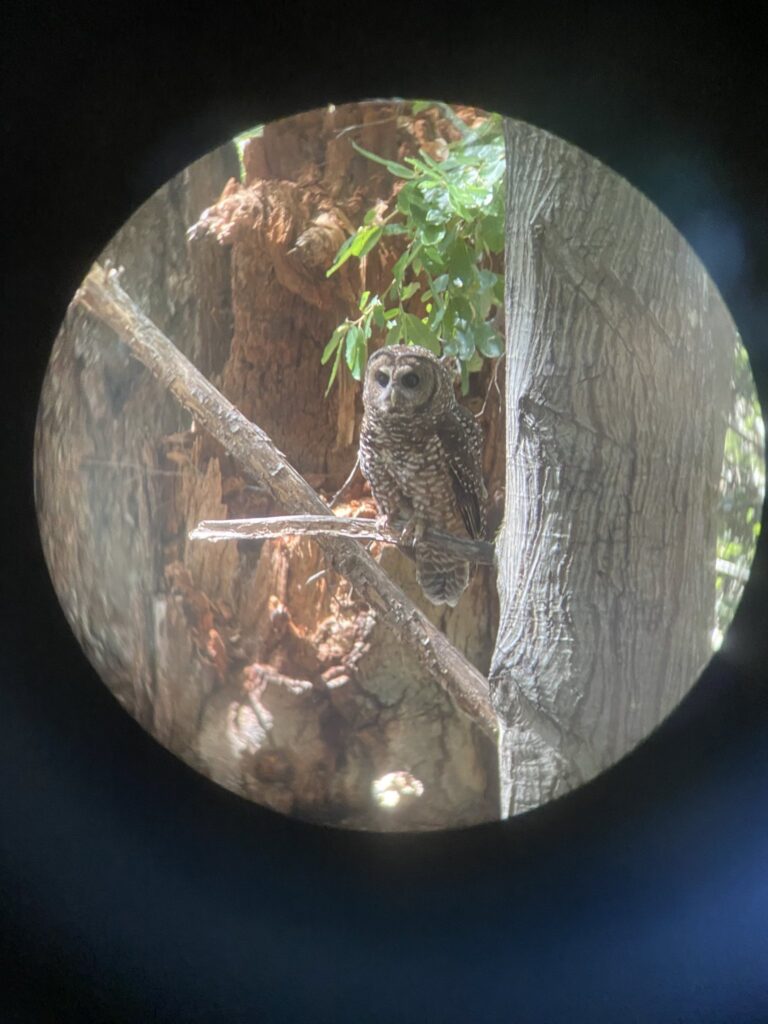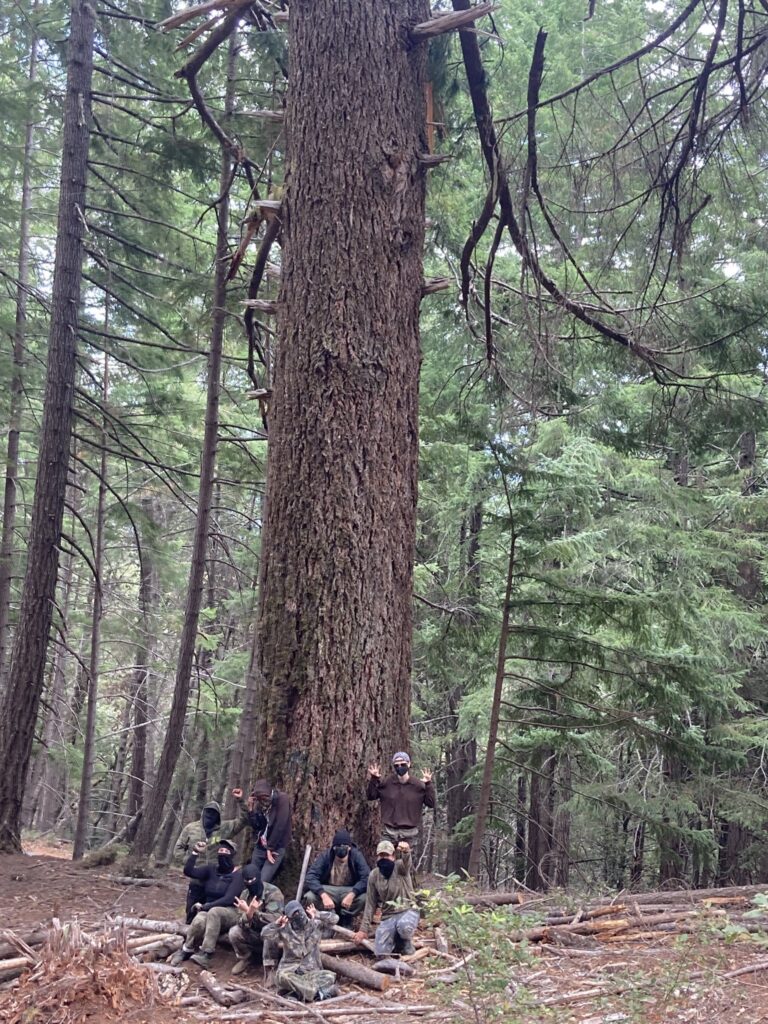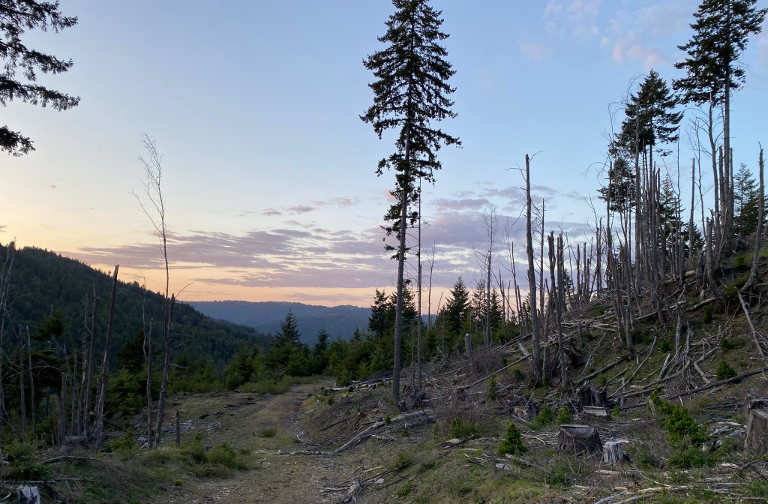In defense of the forest[1]
Dedicated to Manuel Tortuguita, forest defender from Atlanta, murdered by the police on January 18, 2023. “They killed them like they tear down trees in the forest—a forest Manuel loved with passion,” said Belkis, Manuel’s mother.
Timber Wars[2]
A customer entering Home Depot, the largest home improvement retailer in the United States, will find elegant redwood with a certification of “sustainable forestry” available. Humboldt Redwoods Company (HRC) provides this shiny commodity. The company claims to be reducing the use of herbicides, and selecting trees for cutting, rather than “clear-cutting” (general clearing of an area). The agent that creates the concepts and criteria of selection and of sustainability, however, is the company itself.[3] For instance, they commit not to cut “old growth trees,” despite there being no scientific or consensual definition of the age or conditions that would characterize those. Furthermore, they neglect basic precepts of ecology, such as the need for trees of different ages in a healthy forest, as well as the multiple and complex relationships established in the ecosystem. It is evident that private companies, in the context of a capitalist economy and vague environmental legislation, prioritize their profitability above all—which increases with the image of “sustainability.”
In response to this type of operation, Humboldt County, Northern California, where HRC operates, has a decades-long tradition of activism in defense of the forest, alongside the local Indigenous peoples, and ecologies.[4] The Forest Defenders are self-organized, value direct action, and are determined to intercept all possible logging activity. In a horizontal way, participants decide the next actions and execute them. The activists’ tactic involves hindering the company’s actions, as well as reducing/zeroing the profit that comes from logging. The longer companies have to wait, whine, and negotiate with activists, the less profitable their activity becomes.
Typical forest defense tactics include tree sitting (activists who make the canopy their home for days, weeks, or months, by the installation of a net among a tree’s branches), road blocking (with human bodies or barricades) to prevent the passage of trucks and workers, hanging banners and flags, posing obstacles to the companies’ endeavors, and more. Crews of folks go live in remote areas in the forest, monitoring, being the eyes and ears on logging activity for the wider community. As I learned in a workshop of nonviolent direct action at the camp, points of intervention include sites of production, sites of destruction, sites of consumption, sites of decision-making, and unexamined cultural beliefs (e.g. greenwashing). In another front, “tactivities” include collaborating with local Indigenous peoples, and conducting a biological survey of the territory to produce an ecological database.
Losses as well as striking successes mark the history of the group. For example, in 2015, after a summer-long blockade the HRC cancelled 800 to 1000 of thousands of acres of proposed helicopter logging on Long Ridge and upper North Fork of the Mattole River. Blockades in the region again prevented all logging in 2017 and 2018. On Rainbow Ridge, abundant intact late seral forest is a reminder and an effect of twenty years of successful direct action. The reason why I could enjoy an uneventful, peaceful afternoon while sitting there on the lookout, with a group, watching the road to spot trucks is because fellow comrades, decades ago, sat on the same spot for the same reason.

spotted owl (native species endangered by heavy logging)
A week at a forest defense camp
Some forest defenders dedicate their lives entirely to activism, and larger groups sporadically gather in “action camps” for preparation, trainings, planning, and executing actions. In the camp I attended for a week, we led ourselves in a self-organized manner to structure domestic and activist activities. A constant flow of knowledge is shared: there are trainings and workshops on nonviolent direct action (NVDA), tree climbing, reading and interpretation of maps, and whatever else that someone is willing to teach. There were always people reading books or writing in their notebooks, and often someone playing a musical instrument will unfold into a spontaneous jam session.
The aesthetic and political orientation is anarchist, punk, and queer: tattooed, pierced people, free from gender binarism. It is common practice in spaces like this to express the pronouns by which one prefers to be referred to—such as she, he, they, it, or others. The chosen pronouns often break the expectations established by social conventions and point to the social reinvention that is born out of self-determination. In such a context of activism, it is also usual practice to choose fictitious names for the occasion (“camp names” or “forest names”). As in the spirit of “La Casa de Papel,” not knowing the identity of others favors the safety of the group and its members. While some people opt for human names, most have fun with creative names such as “Leaf,” “Stick,” “Raspberry,” “Fennel,” “Saturn,” “Sidewalk,” etc.
Part of the experience of attending a forest defense camp is getting to know the land, spending time with ancestral trees, connecting with the place. While we sat around them, one forest defender shared she heard a tree humming the day before. What are they telling us? One night, we slept under the stars and the trees, feeling their breeze on our faces. We hung our food supplies up on trees’ branches, in case a hungry bear passed by. Forest defenders are masters of survival and of protection. They elaborate logistics, calculate distances, hide bags, mask faces, create names, blur identities, and save forests. “Be mindful of each other, so we can be dangerous together.”

one of the many old-growth trees we saved from PG&E
We had a large rustic wooden barn as a base, and groups in action would set out to camp near the forest to be defended. We prepared communal meals, and held lively and humorous meetings daily. Each night, a different person, usually (but not always) among the most experienced, took the initiative to convene the meeting and mediate it. The meetings took place in high spirits and playing with themes like “this is a non-meeting that I’m non-mediating!” The humor is a layer on the surface of deep collective knowledge and years of accumulated experience in group facilitation and processes of decision-making by consensus, which require refined kinds communication, listening, and responsibility.
An agenda would be proposed for the meeting, and followed in order to arrive at deliberations and concrete plans for the next day, including actions, organization of rides, preparation of meals, etc. This maintained the well-established freedom to do whatever one wants throughout the day—participate in any of the planned activities or none of them. People were sweet, willing, generous, and savvy. Food was delicious. Knowledge was offered freely, and agreements were respected—for example, no cigarettes inside, and quiet time after 11:30pm. All was thoroughly self-organized. “See something, clean something!” It was a relaxed time, as the logging season had not quite started. Other camps may deal with more action and confrontation.
“Sustainable” timber: Who sustains what?[5]
Pacific Lumber, for decades one of California’s largest contractors and known as the “Redwoods Empire,” went bankrupt in 2007, and Humboldt Redwoods Co. is its successor. Pacific Lumber’s downfall was due to decades of extractive forest management.[6] What was fiscally unsustainable also was ecologically unsustainable—they cut so much in such a short time that there was soon nothing left to log. Almost all the regional watershed’s forest has been logged since the 1950s. It was an almost thorough ecocide: 5% remain of the region’s original redwood forests, which use to comprise about 2 million acres. The reason there are still ancient trees in the area is because forest defenders’ efforts protected them. Those logged forests are slowly regrowing, but they are unprotected by law. Because many areas are still too young to be harvested, and the timber is of poor quality, HRC has been determined to log on Rainbow Ridge, one of the only areas the company occupies that has profitable timber.

an area targeted for logging by Humboldt Redwood Company. in the photo from left to right the trees are a madrone, a douglas fir and a tanoak. and of course a forest defender walking under them
Currently, the two biggest opponents of the forest are HRC, dedicated to the sale of wood, and the electric company PG&E. The electric company struggles to repair its public image after being responsible for causing the massive fires that swept the region in 2021.[7] Its response was to order the cutting of trees that surround the power lines. The answer, in addition to being non-ecological, is of limited effectiveness, compared to alternatives such as burying electrical lines or enhancing equipment protection, considering that most fires are caused by equipment failures.[8]
Both companies seek, as is typical in the capitalist economy, to extract the maximum possible rate of profit from the ecosystem, dispossessing local peoples and ignoring the dense mesh of relationships that make up a living and healthy forest. The Bear River Band, whose ancestral territory includes much of the Mattole watershed, are actively buying back parcels of their land in the Mattole valley after being historically displaced and dispossessed. They are rekindling cultural traditions in the valley and working alongside settlers’ NGOs and government agencies on conservation measures in the watershed. While the Band has been able to buy other properties, so far Humboldt Redwood Company has not sold timberlands to the Bear River Band. The company went so far as to deny the band access to conduct state-approved biological surveys across their territory.
The context is one of intense tension between activists and the companies committed to logging; a tension that often leads to the arrest of activists and, in some cases, to their physical debilitation or even death. In 1998, a tree was cut down and killed activist David Chain while he resisted the actions of the Pacific Lumber Co., the dominant timber enterprise at the time. According to protesters, the company deliberately cut down huge trees making them fall in a perpendicular manner, to threaten activists. Similarly, in Atlanta, January 18, 2023, Manuel Tortuguita was shot and killed by the police for defending the forest.
Futures
Redwoods, present in Northern California, are immense trees that can reach 300 feet in height—the tallest trees on Earth—and live over 2,000 years. Neighboring them, Douglas fir, Madrone, Tamoak, Live Oak, Bay Laurel, and other tree species populate the Matolle Watershed and Rainbow Ridge. In addition to being majestic, they benefit their ecological community in myriad ways, including the preservation of rivers, animal species/biodiversity, and the typical benefits of forests such as carbon sequestration, soil building, moderating the climate, and more.
The effects of deforestation are not restricted to the area in which they occur: the disturbance of vegetation and soils can result in erosion and floods that cause intense and irreversible damage to the biome and the habitat of the species that populate it. At this point in time, pressed by climate and ecological crises, the destruction of forests is exponentially murderous. Learning from, and collaborating with, Indigenous peoples, forest defenders, trees, and the multitudes that compose a forest might be essential to finding ways forward.
To know more, follow @treesittersunion.local707, @blockadia, and @redwoodforestdefense on Instagram. To join the actions, contact forestaction@riseup.net.
***
References:
Bari, Judi. Timber Wars. Monroe, ME: Common Courage Press, 1994.
Foster, John Bellamy. The vulnerable planet: A short economic history of the environment. NYU Press, 1999.
Widick, Richard. Trouble in the forest: California’s redwood timber wars. U of Minnesota Press, 2009.
[1] With thanks to the two forest defenders who read multiple version of this text and enriched it with their feedback, their knowledge, and their first-hand photos.
[2] “Timber Wars” is the title of a podcast that tells the history of conflict between timber companies and forest defenders in the Pacific Northwest in the 1990s. Available at: https://www.npr.org/podcasts/906829608/timber-wars. It is also how Judi Bari (1994) and Richard Widick (2009) refer to this conflict in their books.
[3] The company submits such criteria and conditions are to the California Department of Forestry (CDF) via a “Timber Harvest Plan” (THP).
[4] Specific names of peoples, places and persons will be kept confidential for the benefit of their security (protocoled approach among the groups in question).
[5] About loss of forests and peoples: one century after 1492, the global Indigenous population had declined in 90%. Since the development of industrial agriculture, 8 million km2 of forests were lost as a result of human action—75% of this after 1680. Half of the world’s forests loss happened between 1950 and 1990, from active human destruction. Between 1970 and 1990, the world’s deserts expanded in 120 million hectares. Half of the world’s species find habitat in tropical forests—the species that resist, out of the 3 extinctions per hour, 74 extinctions a day, 27000 species extinct per year (Foster, 1999). There is no sustainable way to put forests down.
[6] Pacific Lumber had been a family run company that was well regarded by the community for offering good jobs. In the 1980s the company was taken over by a Texan venture capitalist named Charles Hurwitz who accelerated the clear-cutting, liquidating the company and leaving workers high and dry. There was a period of powerful collaboration between environmentalists and timber industry workers in the 90s as both groups struggled together against this corporate profiteering.
[7] “California finds PG&E equipment responsible for massive Dixie Fire.” CNBC.
[8]“How PG&E Ignored Fire Risks in Favor of Profits”. New York Times.
https://www.nytimes.com/interactive/2019/03/18/business/pge-california-wildfires.html
Teaser photo credit; what we are trying to stop- damage done by Humboldt Redwood Company, courtesy of the forest defenders.





